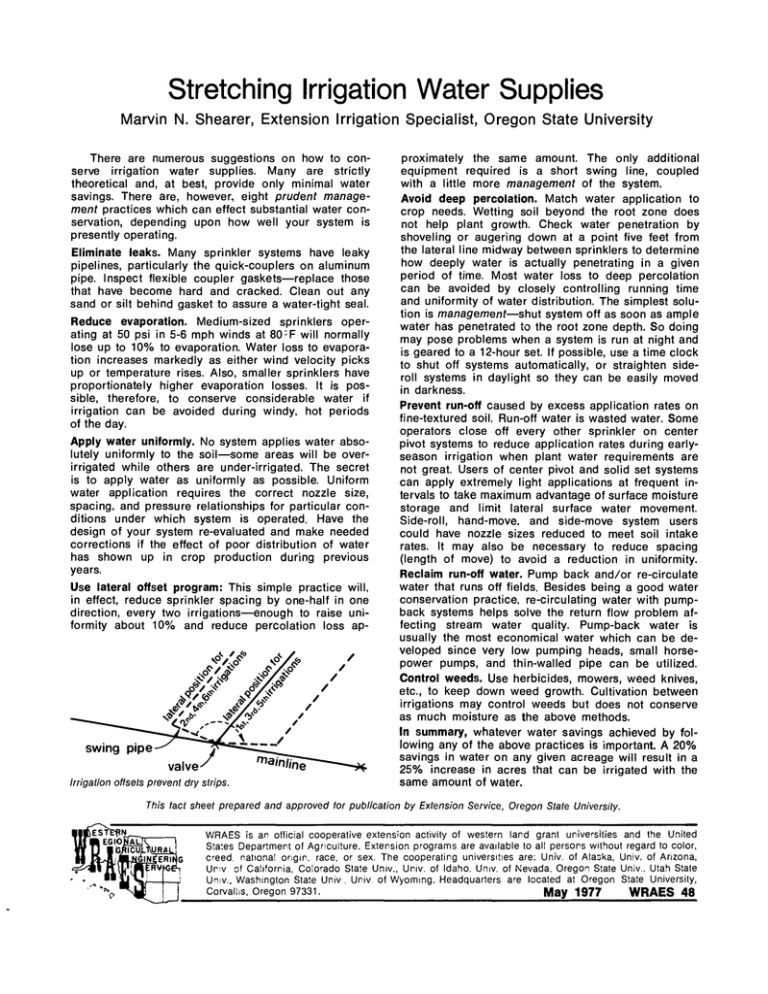Stretching Irrigation Water Supplies
advertisement

Stretching Irrigation Water Supplies Marvin N. Shearer, Extension Irrigation Specialist, Oregon State University There are numerous suggestions on how to conserve irrigation water supplies. Many are strictly theoretical and, at best, provide only minimal water savings. There are, however, eight prudent management practices which can effect substantial water conservation, depending upon how well your system is presently operating. Eliminate leaks. Many sprinkler systems have leaky pipelines, particularly the quick-couplers on aluminum pipe. Inspect flexible coupler gaskets—replace those that have become hard and cracked. Clean out any sand or silt behind gasket to assure a water-tight seal. Reduce evaporation. Medium-sized sprinklers operating at 50 psi in 5-6 mph winds at 80:F will normally lose up to 10% to evaporation. Water loss to evaporation increases markedly as either wind velocity picks up or temperature rises. Also, smaller sprinklers have proportionately higher evaporation losses. It is possible, therefore, to conserve considerable water if irrigation can be avoided during windy, hot periods of the day. Apply water uniformly. No system applies water absolutely uniformly to the soil—some areas will be overirrigated while others are under-irrigated. The secret is to apply water as uniformly as possible. Uniform water application requires the correct nozzle size, spacing, and pressure relationships for particular conditions under which system is operated. Have the design of your system re-evaluated and make needed corrections if the effect of poor distribution of water has shown up in crop production during previous years. Use lateral offset program: This simple practice in effect, reduce sprinkler spacing by one-half in direction, every two irrigations—enough to raise formity about 10% and reduce percolation loss //^ ^'j? fir JSP / -3swing pipe- valve^ Irrigation offsets prevent dry strips. will, one uniap- proximately the same amount. The only additional equipment required is a short swing line, coupled with a little more management of the system. Avoid deep percolation. Match water application to crop needs. Wetting soil beyond the root zone does not help plant growth. Check water penetration by shoveling or augering down at a point five feet from the lateral line midway between sprinklers to determine how deeply water is actually penetrating in a given period of time. Most water loss to deep percolation can be avoided by closely controlling running time and uniformity of water distribution. The simplest solution is management—shut system off as soon as ample water has penetrated to the root zone depth. So doing may pose problems when a system is run at night and is geared to a 12-hour set. If possible, use a time clock to shut off systems automatically, or straighten sideroll systems in daylight so they can be easily moved in darkness. Prevent run-off caused by excess application rates on fine-textured soil. Run-off water is wasted water. Some operators close off every other sprinkler on center pivot systems to reduce application rates during earlyseason irrigation when plant water requirements are not great. Users of center pivot and solid set systems can apply extremely light applications at frequent intervals to take maximum advantage of surface moisture storage and limit lateral surface water movement. Side-roll, hand-move, and side-move system users could have nozzle sizes reduced to meet soil intake rates. It may also be necessary to reduce spacing (length of move) to avoid a reduction in uniformity. Reclaim run-off water. Pump back and/or re-circulate water that runs off fields. Besides being a good water conservation practice, re-circulating water with pumpback systems helps solve the return flow problem affecting stream water quality. Pump-back water is usually the most economical water which can be developed since very low pumping heads, small horsepower pumps, and thin-walled pipe can be utilized. Control weeds. Use herbicides, mowers, weed knives, etc., to keep down weed growth. Cultivation between irrigations may control weeds but does not conserve as much moisture as the above methods. In summary, whatever water savings achieved by following any of the above practices is important. A 20% savings in water on any given acreage will result in a 25% increase in acres that can be irrigated with the same amount of water. This fact sheet prepared and approved for publication by Extension Service, Oregon State University. WRAES is an official cooperative extension activity of western land grant universities and the United States Department of Agriculture. Extension programs are available to all persons without regard to color, creed, national origin, race, or sex. The cooperating universities are: Univ. of Alaska, Univ. of Arizona, Univ of California, Colorado State Univ., Univ. of Idaho. Univ. of Nevada. Oregon State Univ.. Utah State Univ., Washington State Univ . Univ. of Wyoming. Headquarters are located at Oregon State University, Corvallis, Oregon 97331. May 1977 WRAES 48

